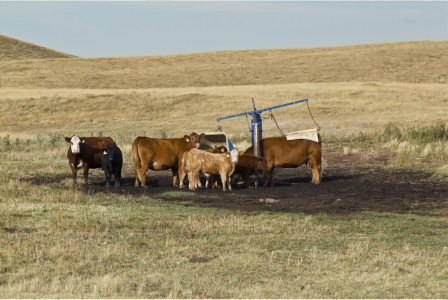More Questions on Mineral Nutrition
This article written by Dr. John McKinnon, University of Saskatchewan beef cattle nutrition researcher and professor, originally appeared in the March 2017 issue of Canadian Cattlemen magazine and is reprinted on the BCRC Blog with permission of the publisher.

Last month I had the opportunity to attend the Saskatchewan Beef Industry Conference. As with similar events held across the country, the objective was to transfer current research and technology to beef producers. One of the most interesting aspects of this conference was a bear-pit session hosted by the Beef Cattle Research Council which focused on reproductive rates in spring calving cows. This session addressed the question: “Were producers who had moved to later calving experiencing a drop in their pregnancy rates?” What really got my attention was when the discussion turned to trace minerals. While I was not surprised to hear that trace mineral deficiency is associated with open cows, I was surprised about the wide range of questions and to some extent the confusion that producers had with respect to trace mineral nutrition. Questions included:
- What is the trace mineral concentration of tame and native grasses and how valuable are they in meeting requirements?
- What is the role of sulphur and molybdenum in copper deficiency?
- What is the appropriate level of individual trace minerals for my mineral supplement and what form of minerals should I purchase?
- Do I need to feed minerals year-round?
- My cows will not eat mineral or they will not stop eating mineral — what can I do?
I suspect that these questions are not restricted to those present at this meeting and it would be a worthwhile use of this and next month’s column to answer these questions for a wider audience.
Let’s look at the question regarding trace mineral concentrations in tame and native forages and do they meet the animal’s requirements. Levels of minerals in a given forage will depend on a variety of factors including soil type, plant species and stage of growth, weather, and forage management. While we can make generalizations as to approximate levels, the only way to know for sure is to have your forages analyzed. More importantly, as a nutritionist, I am not sure that copper or zinc levels in your forage are all that important. I say that because absorption of trace minerals from the gastrointestinal tract of the animal is extremely poor and in some situations non-existent. For example, only about five per cent of copper in forages fed to mature cattle is absorbed, regardless of forage source. Combine this with copper antagonists such as high sulphate in water or high molybdenum forages and copper absorption from the diet is essentially zero! A similar situation exists for manganese and to a lesser extent zinc. This poor absorption of trace minerals is the reason why dietary requirements are set significantly higher than the actual requirement of the animal.
Another question that arose related to the concentration of a given mineral — what is the optimum level? When you look at the vast array of minerals on the market and the range in their formulations, it is not surprising that confusion exists. The answer to this question lies in the mineral tag. Trace mineral levels are typically listed on the tag as milligrams per kilogram (mg/kg) or parts per million (ppm). Adequate intake of a specific mineral such as copper will depend on its concentration in the mineral supplement and the expected intake listed on the tag. For example, take two mineral supplements, one that contains 3,000 mg/kg and one that contains 1,000 mg/kg of copper. If expected consumption is 70 grams per day (i.e. 2.5 ounces), an animal will consume approximately 210 milligrams of copper with the first mineral and only 70 milligrams with the second. The first mineral consumed at targeted levels will meet copper requirements of most cattle; however, the second mineral will likely result in a copper deficiency, particularly if there are issues with high-sulphate water or high-molybdenum forages. Understanding your mineral tag is critical to selecting the right mineral. Don’t just look at the price tag!
I have already alluded to the fact that certain dietary constituents such as sulphur and molybdenum can interfere with trace mineral absorption, particularly copper. High levels of these antagonists can lead to a secondary copper deficiency and result in open or late breeding females. Having your water tested for sulphate content and forages for their molybdenum content are important steps to take before deciding which mineral is right for your herd and can be used as diagnostic tools in cases of trace mineral deficiency.
Trace minerals can be purchased as inorganic or organic minerals. Inorganic minerals are most common and include chemical complexes with oxides, chlorides and sulphates (i.e. copper oxide versus copper sulphate). Complexes with sulphates tend to be more available than those with oxides. Organic minerals are also referred to as chelated minerals and are complexed to protein or amino acids or natural forms such as yeast-based minerals. The form of the mineral will have a large influence on the price as well as the effectiveness of your mineral program. Inorganic minerals while cheaper are not absorbed as effectively as chelated minerals and thus are not as effective in eliminating a deficiency.
Next article, we will look at the need for year-round mineral supplementation, when you should feed chelated minerals and that tricky question, how to regulate mineral consumption.
Click here to subscribe to the BCRC Blog and receive email notifications when new content is posted.
The sharing or reprinting of BCRC Blog articles is typically welcome and encouraged, however this article requires permission of the original publisher.
We welcome your questions, comments and suggestions. Contact us directly or generate public discussion by posting your thoughts below.
